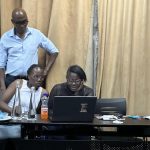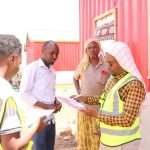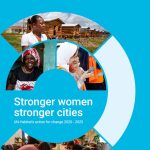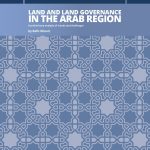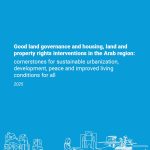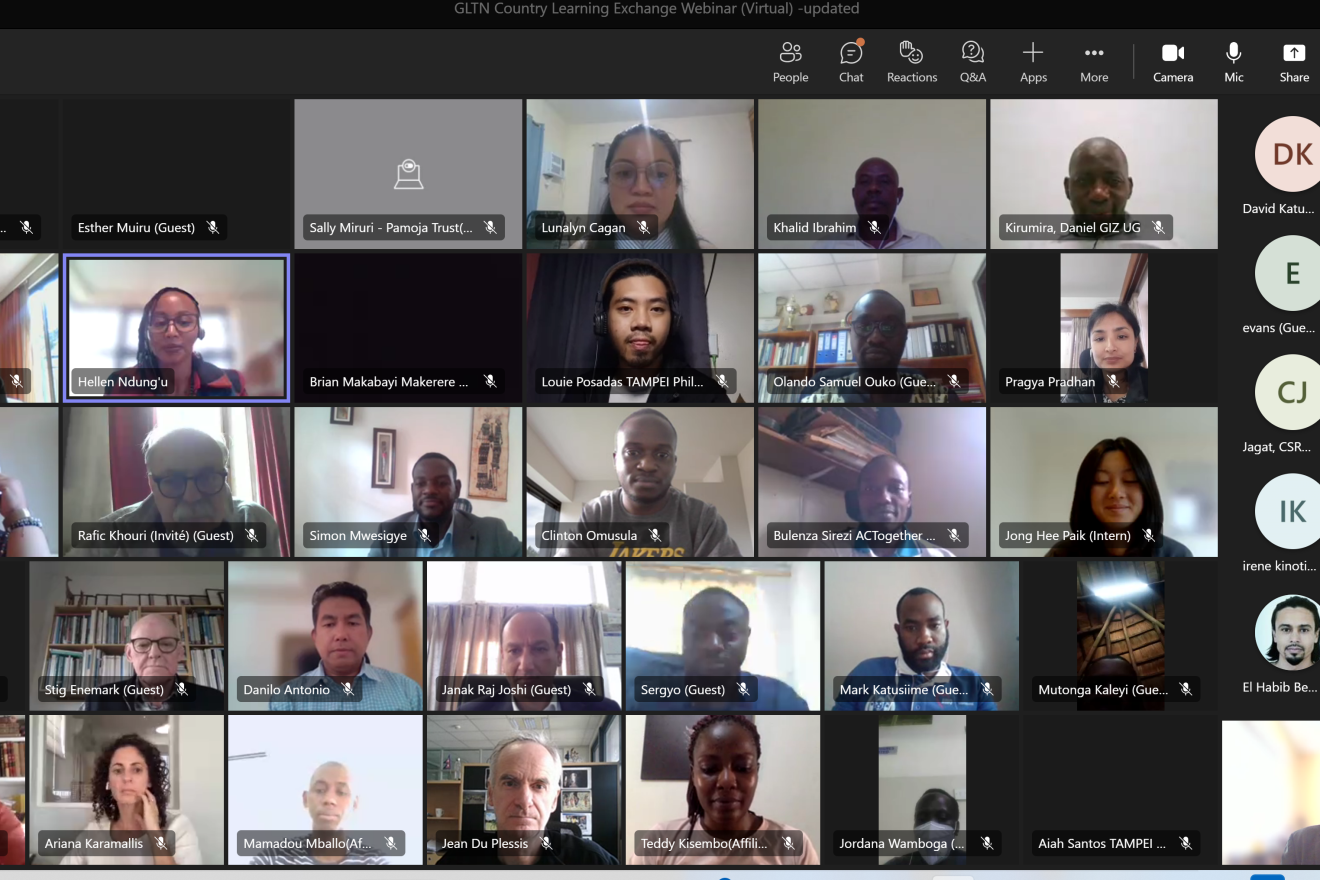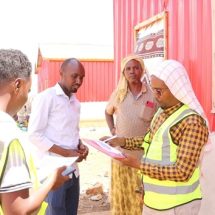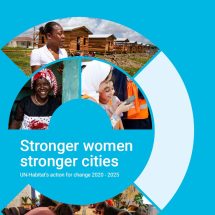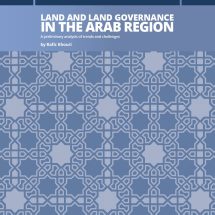The GLTN Country Learning Exchange was conducted on the 29th and 30th of November 2022, bringing together Partners to convene and share lessons, experiences, and the best practices of their land tenure related projects during the third phase of GLTN’s programme implementation (2019-2023). The event had a total of sixty-nine (69) participants, most of whom were implementing partners including government authorities, civil society organizations, the academia, and other land stakeholders at country level from 14 countries in Africa, and from Southern and Western Asia. These included the Democratic Republic of the Congo, Iraq, Kenya, Lebanon, Namibia, Nepal, Palestine, Philippines, Somalia, Sudan, Syria, Uganda, Yemen, and Zambia. The interactive sessions were an opportunity for the partners implementing GLTN supported country-level interventions to exchange notes and to learn from one another, assess the relevance of approaches adopted in different countries, recognize successes so far, and to explore areas of collaboration, partnerships, and synergies for scaling up purposes.
A key highlight was the presentation of country experiences under different thematic areas which included: land policy development; customary land rights certifications; tenure improvement and upgrading in the informal settlements; land, housing, and property rights recognition in post-conflict settings; and the establishment of digital land registries. These presentations were supported by ‘reactions’ from countries/partners working on similar thematic areas with specific focus on differentiated learning experiences from the participating countries.
It is evident that in the current phase of programme implementation (2019-2023), great strides have been made towards land tools uptake and integration in the different countries, which has enabled improved tenure security for all, including for women, youth, and vulnerable groups in both urban and rural settings. Further, there has been a demand-driven increase of country interventions by governments at both national and local levels, in collaboration with civil society organizations and the academia, and as such an enhanced political will towards the development and/or revision of national land policies and other legal framework to ensure that all citizens have secure land tenure. Significant achievement has also been registered on capacity development efforts on GLTN land tools including on increasing awareness on the linkages between land tenure security and conflict, to mitigate land-related causes of instability and to facilitate the recovery of lost land rights and promote community resettlement towards lasting peace. It is also worth highlighting that the Network has undertaken various interventions focusing on reducing vulnerabilities to climate change impacts, including projects on tenure-responsive land-use planning and climate-smart agriculture to facilitate environmental sustainability including natural resource management.
Some key takeaways
“Land matters, land issues are important. In global and national discourses, land is a constant theme in political and socio-economic life, and we cannot lose focus on this. The focus of country work at GLTN is particularly important because it is where we learn, as a Network, to keep an eye on what is needed to solve land issues globally. Identifying what is needed comes from the country level work and consequent to that, the different options to land management. Country level work acts as proving ground on what works and what does not while appreciating the different contexts and bringing together partners to learn from each other”- Robert Lewis-Lettington– Chief of Section, Land, Housing and Shelter, and Secretary of the Global Land Tool Network.
“The case of Nepal and Fit-For-Purpose Land Administration implementation can be used as a model for many countries working on providing secure land rights at scale”-Stig Enemark– Honorary president of the FIG, and professor emeritus of land management in the Department of Development and Planning, Aalborg University, Denmark.
“Implementation of land reforms has been a journey at the country level. Given the magnitude and complexity of land issues, GLTN’s interventions are comparably small. We have, as a Network, gained traction with regards to influencing national land policies and other regulatory frameworks, we have been able to improve tenure security for vulnerable communities particularly in customary land areas, post conflict areas and in the informal settlements. Tool implementation at country level has not only influenced policy and other regulatory frameworks, but it has also demonstrated that land tools work, to improve tenure security. Also, these tools are being implemented by grassroot people with support from GLTN, CSOs and academic institutions hence building and enhancing capacity of change agents for sustainable land governance”- Danilo Antonio, -Programme Management Officer, UN-Habitat and lead and coordinator of country operations and tools development of the Global Land Tool Network.
“The success stories shared through the country presentations are very encouraging and exciting from an STDM Advisory Committee perspective. However, challenges remain, for example on women and youth land rights. Different workflows exist in all the projects at country level, and it is important to have a repository of these workflows in standardized description which can be applied by different Partners, in varied contexts after appropriate customization. Discussions in the chat room have pointed to the digitization of hand drawn maps. Most of the Partners are collecting data using hand drawn ad sketch maps. The process of digitization is very important so that it is not always a case of doing this manually. The Network also needs to ensure that the data generated using the tools is maintained and recognized moving forward in the future, and that it does not become stale after the projects have ended. Also, GLTN has a strong focus on tool development and with this capacity development. However, capacity development does not automatically mean sustainability. There is need for more diffusion of these tools at country level in the national conversations.” Malumbo Chipofya– Ass. Professor of Land Informatics, Department of Urban and Regional Planning and Geo-Information Management, University of Twente, and a member of the STDM Advisory Committee.
“Gains made in recording and building social recognition of land holdings should be supported through building reciprocal official acknowledgment (social compacts, shifts in government policy, etc.) and, in due course, formal legal backing. Otherwise, they can be wiped away, particularly if/when the land being held increases in value (e.g., through surrounding urbanization and infrastructure development), and becomes attractive to elites or other powerful groupings. It would be great to record those cases where this has happened, and descriptions of the various routes by which this was achieved”- Jean du Plessis, Land Specialist and capacity building expert at Land, Housing and Shelter Section, UN-Habitat.
“The funding mechanism is changing and one of the of the things that we notice at country level is that donors are moving more towards giving loans as opposed to grants. As a Network, we need to strategize and position ourselves to be able to influence that kind of funding. We must be able to tell our stories better, and to use lessons learned to influence this available funding at country level, to scale up and sustain what we are doing. Secondly, we need to push for more long-term funding for country level work to enable transformation such as institutional reform, policy reform, but also at the community level, the social and cultural norms transformation. These kinds of interventions require a long-term commitment and funding. Finally, as a Network, we should explore how to tackle corruption in land through the available land tools. How can we increase transparency and accountability in the sector? The Network needs to play a huge role in this area”-Simon Mwesigye, Land Tenure Specialist, UN-Habitat, and coordinator of the GLTN work in Uganda.
“On the discussion about resources and capacities, what’s available and what we can do. In a recent GLTN meeting in southern Africa of research and academic institutions, we thought it best that we review what role academic institutions can play sometimes dedicated to developing new knowledge and applying it, but at other times, the relationships that can be built, for example, with policymakers. As clusters we need to go back and think about the newer innovative and additional roles that we can take on, directly and indirectly. Funding might not be available directly but collaborations through the private sector or through the professional groups can help. The second is the inter-cluster collaborations where we can leverage much better by presenting our case stronger, not just planning and design, but also follow up. Lastly, is on advocacy, advocacy within our respective domains, but also presenting updates of newer changes that have taken place. As Partners, we are looking forward to the steering committee, and the Partners meeting to clearly identify where changes are taking place which is critical, and the opportunities Phase Four offers to GLTN, and the Partners themselves.” Siraj Sait-Professor of law and development at the University of East London and United Nations consultant on land and housing, human rights, and gender equality.
“As a Network, we are proponents of fit for purpose and gender equitable land tools and have attempted to use tools in devising a simple, efficient, and relatively cheap approaches and methodologies to policy development and reforms, land rights certification and recognition and land data digitization. The land tools are meant to facilitate the change. However, progress and success of the interventions will depend on the openness of the stakeholders, in particular the partner communities and the government. If the communities do not understand and appreciate the relevance and the use of the tools, the interventions will remain as projects. For governments, if there is no political will to revise land policies and undertake land reforms then land tenure security will not be enforced. Also, a multi stakeholder approach contributes to the gains of the Network’s interventions, and there is need to engage different actors in a participatory manner. Sustainability of our efforts is the measure of success. Hence, we should be prudent in setting our standards of success or scaling up in relation to the interventions we have invested. This should be done while contemplating what we will be discussing heading to the Partners meeting, and the next phase of GLTN. We also need to continuously educate the donor community on the complexity of addressing land tenure security, but at the same time it’s positive contribution to food security, sustainable resource management, attaining peace. Clearly, donors need to redefine their metrics and theories of change. These areas of actions are beyond land tool implementation and are in fact related to the other strategies of GLTN as of network”- Don Nathaniel Marquez– Executive Director of the Asian NGO Coalition for Agrarian Reform and Rural Development (ANGOC).
The above is a summary of the two-day proceedings; a full report is being developed to be shared to all Partners in due course. GLTN is currently preparing for the Partners meeting to take place in early 2023 where broader discussions and reflection on GLTN phase 3 programme shall be conducted to review performance and support forward planning. In addition, discussions for the proposed fourth phase (2024-2027) shall take centre stage as the Network continues to position itself to contribute to the land sector in transforming the global land commitments into appropriate tools and approaches that enable countries to increase tenure security for all.

